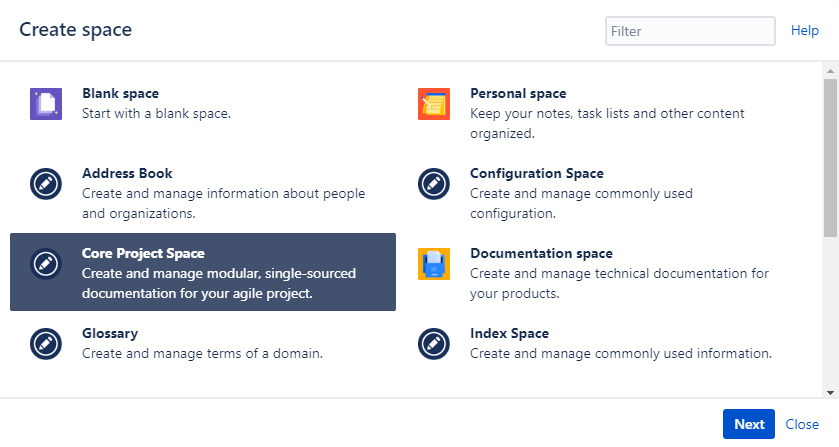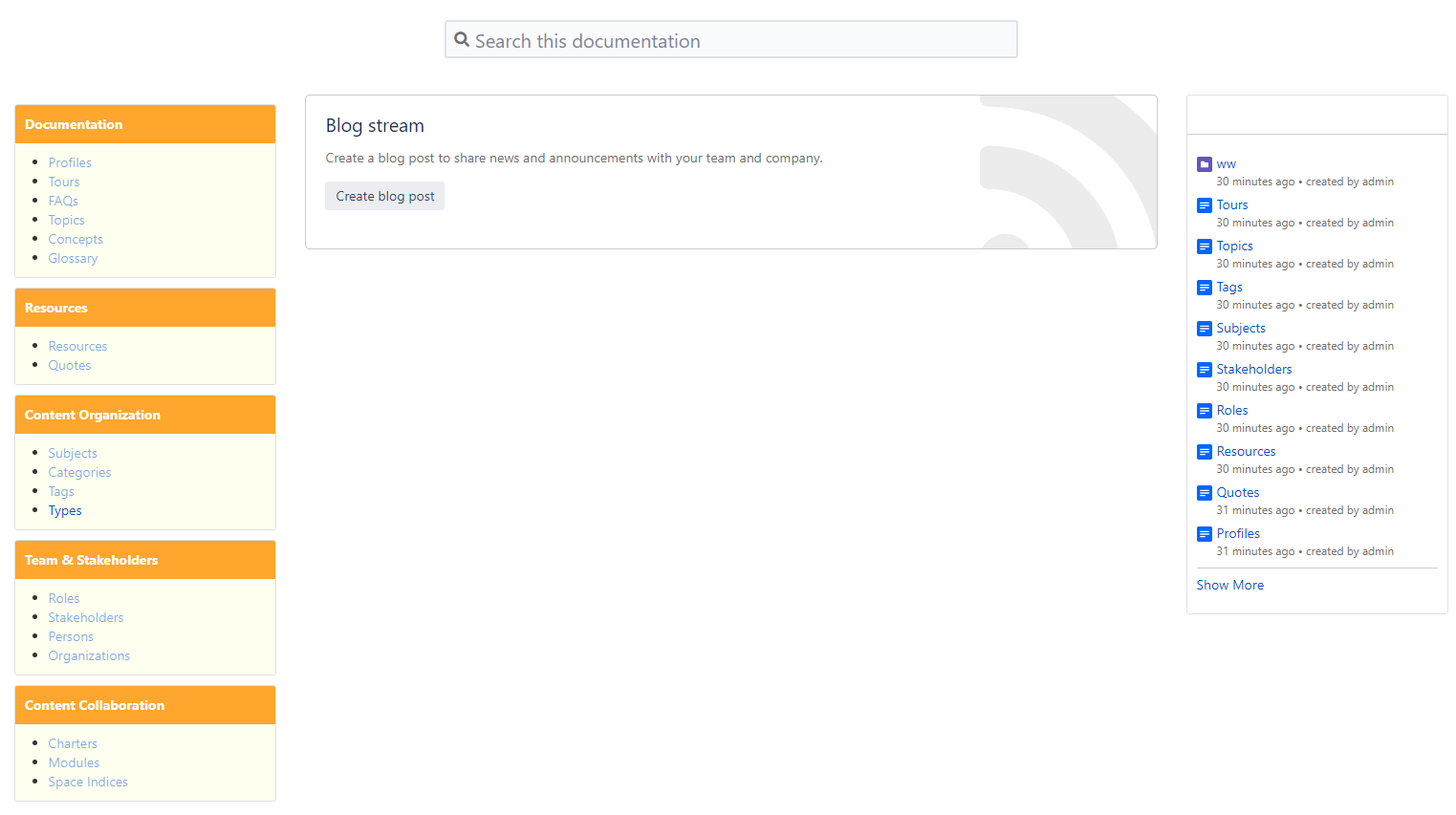Provides a basic set of doctypes to create agile documentation.
The core doctypes provide the base for your agile documentation work with the projectdoc Toolbox for Confluence. You may also use them as an inspiration for designing your own templates that meet exactly the requirements of your project.
Please refer to Tour for Document Authors for an introduction on how to use these templates and to Tour for Template Authors for information on how to design your own templates.
You may also take an alternative introduction to the Core Doctypes by a Prezi presentation. The presentation provides a good overview by grouping closely related doctypes.
Create a Space
To get started with the Core Doctypes, we recommend to create an Core Project Space.

This provides the basic structure to add new documents easily by the use of home and index pages. This is how the space looks like:

If you prefer to start with a relatively blank space, consider to choose the Configuration Space. It creates a home page and an index page for type documents.
List of Space Blueprints
The following space blueprints are provided by the Core Doctypes.
- Address Book
Manage information about people and their roles and interests in a product or project. This space contains information about roles, persons, and organizations.
- Configuration Space
Manage commonly used configurations without any subdocuments (besides a homepage for type homepages).
- Core Project Space
Create a space to organize information for your agile team. A basic structure with homepages is created, such as for tags, topics, or roles).
- Glossary
Manage information about a domain. Add glossary items and associate them with domain information.
- Index Space
Collect commonly used information like spaces properties or type documents. You may also include fragments to be used by transclusion or other information that is relevant for all dependent spaces.
- Library
Manage information about resources. This includes books, articles, podcasts, as well as information about the authors of these resources.
- Topic Space
- Create a space to collect and organize information on a topic.
- Workspace
Create a space to collaboratively collect information on a specific topic. A workspace does not demand for updating information. It is a place to work with until a goal is reached. Move the result of your research to topic spaces and discard or archive this space.
List of Doctypes
The doctypes provided by Core Doctypes are very basic and sometimes generic. Note that there are additional doctype add-ons that support the documentation of more specific domains. The doctypes provided by Core Doctypes are often also used in these domains, for instances roles or tags.
The following doctypes help to organize core project or product information.
| # | Name | Short Description | Documentation Type | Categories |
|---|---|---|---|---|
| 1 | Associates two documents. |
|||
| 2 | Categorize associations by a type. |
|||
| 3 | Categories allow to set document instance of different doctypes in a hierarchy. |
|||
| 4 | Categorize categories by a type. |
|||
| 5 | Describes an information need and use this description as a basis to create and maintain a document. |
|||
| 6 | Categorize charters by a type. |
|||
| 7 | Excerpts are abstracts of information found in a resource, such as a book. If you want to go into more detail for a given resource, there may be multiple excerpts as subpages of the resource document. |
|||
| 8 | Categorize excerpts by a type. |
|||
| 9 | Defines the context through which readers acquire skills. The level sets the expectation on the author's techniques to teach. |
|||
| 10 | Categorize experience levels by a type. |
|||
| 11 | FAQs help to record an answer to a frequently asked question concerning the project, the product, the system or the process. |
Documentation |
||
| 12 | Categorize FAQs by a type. |
|||
| 13 | Generic Documents provide information where no other doctype matches. |
|||
| 14 | Categorize generic documents by a type. |
|||
| 15 | Glossary items are part of the domain glossary for the project. Glossaries support the team to use terms of the domain consistently in conversations and documentation. |
|||
| 16 | Categorize glossary items by a type. |
|||
| 17 | Resources are identified by their media type. This may be the MIME type, but also a human readable string, that identifies the syntactic format. |
|||
| 18 | Categorize media types by their type. |
|||
| 19 | Metadata documents provide tables of simple key/value pairs. This information can be used as an aspect or as additional space properties to be available for reference on your wiki. |
|||
| 20 | Categorize metadata documents by a type. |
|||
| 21 | A documentation module is a fragment which is usually transcluded by other documents. The lifetime of a module document is independent of the lifetimes of the documents that reference it. |
|||
| 22 | Categorization of document modules for single sourcing. |
|||
| 23 | Information about organizations that take a part in the project. You may collect common information here for all persons that belong to an organization, such as address or homepage. |
|||
| 24 | Categorize organizations by a type. |
|||
| 25 | Provides information about a person. This includes contact information (important if the person is relevant for the team) or information about the competences (if the person is an author about a topic relevant for the project). |
|||
| 26 | Categorize persons by a type. |
|||
| 27 | Profiles provide views on documents via delegation. |
|||
| 28 | Categorize profiles by a type. |
|||
| 29 | Quotes relevant for the project. Allows to store the content and metadata to the quote. |
|||
| 30 | Categorize quotes by a type. |
|||
| 31 | Organizes glossary items. |
|||
| 32 | Categorize relations by a type. |
|||
| 33 | Resources are books, webpages, videocasts relevant for the project. Add important information to your project about resources that lie outside the control of your team. |
|||
| 34 | Resources are identified by their type. This is not the MIME type, but human readable string, that identifies the semantic, rather than the syntactic format. |
|||
| 35 | Defines a role with its responsibilities, tasks and requirements. Roles are incorporated by stakeholders who take interest in the project. The are also used to define the audience for documents. |
|||
| 36 | Categorize roles by a type. |
|||
| 37 | Sections of a document are typically part of a document. But the size of sections may vary. To support a team to write collaboratively on the documentation, a larger document may be subdivided into external section documents. |
|||
| 38 | Categorize sections by a type. |
|||
| 39 | Compile other documents, yet space indices are themselves projectdoc documents. So they can be tagged and grouped. |
|||
| 40 | Categorize space indexes by a type. |
|||
| 41 | A party that takes interest in a project. The stakeholder is either a real person, an organization or group, or represents a class of individuals, groups or organizations. |
|||
| 42 | Categorize stakeholders by a type. |
|||
| 43 | Describes a single step of an activity. A step is a generic document that is associated with a document that describes a process. It may be a test log or a howto. |
|||
| 44 | Categorize steps by a type. |
|||
| 45 | Subject documents allow to set document instance of different doctypes in a common context. |
|||
| 46 | Categorize subjects by a type. |
|||
| 47 | Document the semantics of a tag. May also be used to document Confluence labels. |
|||
| 48 | Categorize tags by a type. |
|||
| 49 | A description of a given topic. A topic may describing or explaining a concept, a task to accomplish or a reference. There are a couple of topic types that set the expectations for the reader. Instances of the topic doctype usually have independent lifetimes from any referencing documents. |
|||
| 50 | A topic type is a semantic type of the topic. It helps to set the expectations of potential readers. |
|||
| 51 | Guided tours through existing information. This allows to aggregate topics for a given question or audience, thus providing a view on a topic. |
|||
| 52 | Document a version of a product or service. |
|||
| 53 | Categorize versions by a type. |
Resources
Related information to work with Core Doctypes.
- Doctypes
- More information on doctypes for the projectdoc Toolbox.
- Extension Doctypes
- List of additional doctypes provided by free add-ons for specific domains.
- Macros
- List of macros from the projectdoc Toolbox to be used in your Confluence blueprints (2013).
- projectdoc Document
- projectdoc is based on projectdoc documents. Creating a projectdoc document is easy: A projectdoc document is a Confluence page using document properties and sections.

